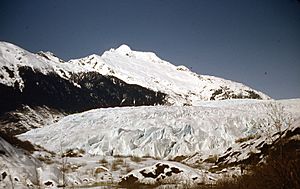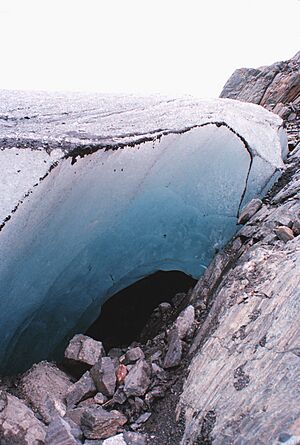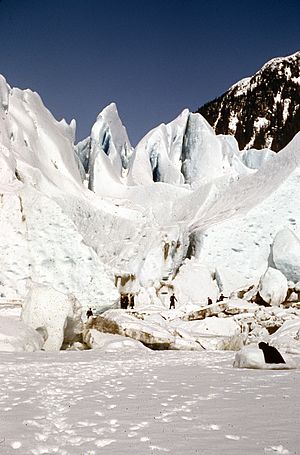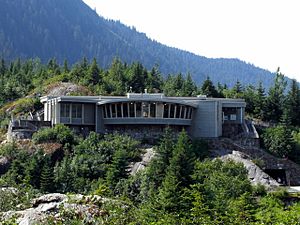Mendenhall Glacier facts for kids
Quick facts for kids Mendenhall Glacier |
|
|---|---|
| Sitaantaagu | |

Mendenhall Glacier and frozen Mendenhall Lake
|
|
| Type | Mountain glacier |
| Location | Coast Range, Juneau, Alaska, U.S. |
| Coordinates | 58°29′45″N 134°31′56″W / 58.49583°N 134.53222°W |
| Terminus | Proglacial lake |
| Status | Retreating |
The Mendenhall Glacier (also called Sitaantaagu) is a huge river of ice about 13.6 miles (22 km) long. It's located in the Mendenhall Valley, which is about 12 miles (19 km) from downtown Juneau in the southeastern part of Alaska, USA. This amazing glacier and the land around it are protected as part of the Mendenhall Glacier Recreation Area. This area covers about 5,815 acres (2,353 hectares) and is part of the Tongass National Forest.
Scientists have been watching the Mendenhall Glacier since 1942. They've seen that the glacier has shrunk quite a bit. Since 1929, it has moved back about 1.75 miles (2.8 km), which is when Mendenhall Lake was formed. It has retreated even more, over 2.5 miles (4 km), since the year 1500! Right now, the glacier is losing more ice than it gains, so it will likely keep getting smaller in the future.
Interestingly, even though the glacier is shrinking, it might slow down or even grow a little bit sometimes. This is because warmer, wetter air could bring more snow to the top of the icefield. This extra snow could help feed the glacier. However, if temperatures keep rising, this effect won't last, as it won't be cold enough for snow to fall.
Contents
What's in a Name?
The native Tlingit people originally called this glacier Sitaantaago, which means "the Glacier Behind the Town." They also called it Aak'wtaaksit, meaning "the Glacier Behind the Little Lake." Later, in 1879, a naturalist named John Muir called it Auke Glacier, after the Tlingit Auk Kwaan band. Finally, in 1891, it was renamed Mendenhall Glacier to honor Thomas Corwin Mendenhall. The glacier starts high up in the Juneau Icefield and flows down to Mendenhall Lake.
Why is the Glacier Shrinking?
What Causes the Retreat?
The Mendenhall Glacier is shrinking because the climate in Southeast Alaska is getting warmer. This warming is linked to global warming and climate change. The US Forest Service, which looks after the glacier, explains that glaciers change because the climate changes. The Mendenhall Glacier has moved back about 2.5 miles (4 km) since the mid-1700s, which was during a cooler period called the Little Ice Age. Experts say that the warmer climate and the breaking off of ice chunks (called calving) are the main reasons the Mendenhall Glacier is getting smaller. Soon, the glacier's end might even pull completely out of the lake.
What are the Negative Effects?

Many people believe that the Mendenhall Glacier shrinking is part of a bigger problem: the Juneau Icefield is also getting smaller. This icefield is the fifth largest in North America! Many communities near glaciers depend on them for fresh drinking water. If these glaciers disappear, people will need to find new water sources. For example, Anchorage, Alaska's biggest city, gets much of its water from the Eklutna glacier. If that glacier keeps shrinking, they will lose their main water supply.
Are There Any Benefits?
Even though glaciers shrinking can cause problems, there are also a few good things that happen. As the Mendenhall Glacier retreats, Mendenhall Lake has grown bigger. This lake is formed from the melting ice and has been growing since 1929. The lake is now home to a special ecosystem. It's a nursery for many kinds of fish, including different types of salmon, Dolly Varden char, and cutthroat trout.
Ancient Forest Uncovered!
In 2012, something amazing happened: old tree stumps and logs with roots and bark appeared from under the retreating glacier! These trees were still in the same spot where they grew thousands of years ago. They had been kept safe under a layer of gravel. By studying these ancient trees, scientists can learn about what the environment was like before the glacier formed. They can even figure out how old the trees were when they died. One scientist found that the newest stumps were about 1,200 to 1,400 years old, while the oldest ones were around 2,350 years old!
Visiting the Glacier
Mendenhall Glacier Visitor Center
The United States Forest Service runs the Mendenhall Glacier Visitor Center. It's part of the Tongass National Forest and offers fun learning programs for kids and adults all year round. From the Visitor Center, you can see amazing views of the glacier and the lake where ice chunks break off. The center is open every day and gets almost 500,000 visitors each year, especially during the summer when many come by cruise ship. There are two easy entrances, one with a ramp and one with elevators.
This was actually the first visitor center ever built by the U.S. Forest Service! It opened in 1962 and was updated in 1999. Inside, you can see exhibits that show the history of Mendenhall Glacier. You can learn how it once covered the whole valley back in 1794, and how different it looks today because of climate change. The exhibits also show the different animals that live in the area, like mountain goats, black bears, and salmon in the nearby streams. Park rangers are there to answer questions and lead nature programs for kids.
Trails and Outdoor Fun
There are several trails you can explore around the Visitor Center. The Photo Point Trail and the Steep Creek Trail are easy to walk. Along Steep Creek, you can see salmon and even bears! You can also hike the East Glacier Loop to get within 1 mile (1.6 km) of the glacier. This trail has wooden steps and goes uphill a bit. The Trail of Time, which connects to the East Glacier Loop, has signs that tell you about the area's history. The Nugget Falls Trail is 0.8 miles (1.3 km) long and takes you to Nugget Falls, a beautiful waterfall close to the glacier. It's free to access the outside areas and trails. The West Glacier trail, located across the lake, lets you get closer to the glacier itself and even see the cool ice caves underneath it.
Fees and Programs
From May to September, you need a pass to go inside the Visitor Center and use some of the outdoor areas like the Steep Creek trail and restrooms. The fee is $5 per person per day, or you can buy a Season's Pass for $15. Kids aged 15 and under are always free! This money helps maintain the center, run programs, and update the exhibits. Over 90% of the money stays right there at the glacier! In winter, there is no fee to enter the center.
All other outdoor activities, like hiking the Nugget Falls trail or the Trail of Time, are always free. Parking is also free.
Besides the busy summer, the center also hosts Fireside Lectures on Friday evenings from January to March. These talks cover interesting topics about nature and culture in Southeast Alaska. Inside the Visitor Center, there's also a bookstore run by a non-profit group. They sell books, guides, and other fun stuff about nature, especially for kids.
Images for kids
-
Mendenhall Glacier and Lake, with Nugget Falls on the right (August 2011)
-
Mendenhall Lake and Glacier from the southeastern edge of the lake (June 2009) Bullard Mountain on right
-
Mendenhall Lake and Glacier from the Visitor's Center (June 2006) (McGinnis Mountain centered)
See also
 In Spanish: Glaciar Mendenhall para niños
In Spanish: Glaciar Mendenhall para niños






